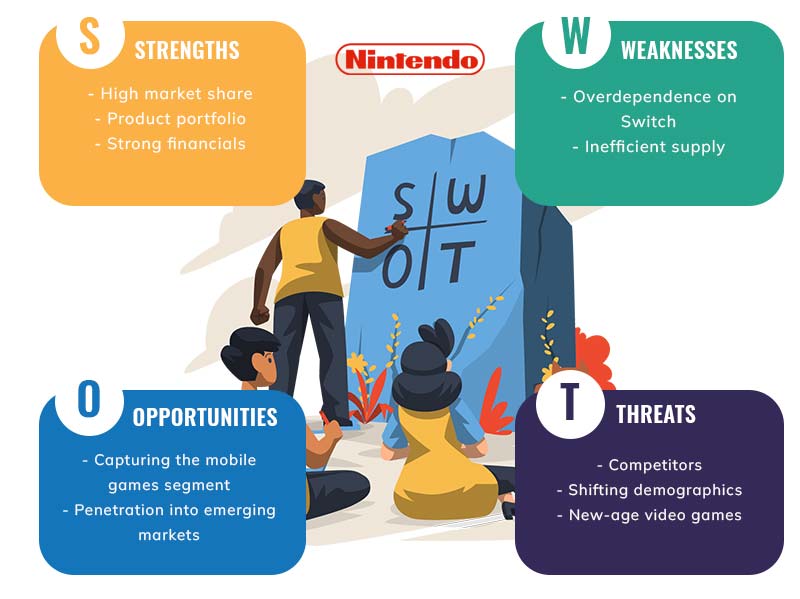Nintendo's Overview
Nintendo has been in existence for long and many generations have cherished its beloved games like Mario, Pokemon, and so on. Nintendo is headquartered in Kyoto, Japan, and over the years it has built a strong multinational presence. Nintendo started its journey in 1889 and today, the company has a market capitalization of more than USD 59 billion as per Yahoo Finance.
This SWOT analysis will look into the internal strengths and weaknesses of the company that determine how well the company is aligned with its strategic goals. Besides, it also delves deep into the opportunities and threats prevalent in the external business environment. In fact, to understand SWOT analysis better, you can go through our extensive SWOT analysis guide.
As for now, let us proceed with the analysis.
Table of Contents
A pragmatic and precise SWOT analysis of Nintendo

Nintendo’s strengths
- High market share- Nintendo has a huge market share of 29% in the video gaming industry. The high market share can provide it with the competitive edge.
- Product portfolio- Nintendo has a diversified product portfolio that includes cards, consoles, games of different genres, etc.
- Strong financials- Nintendo’s revenue has increased by a significant margin over a few years and it has reached $15, 990 million in 2021 from $4581 in 2015. Further, its free cash flow has also increased from 142,599k Yen in 2018 to 605, 095k Yen in 2021. The increase in the cash flow is a positive sign for it as it would provide the company with adequate liquidity to negate threats and tap on the opportunities (Yahoo Finance, 2022).
Nintendo’s Weaknesses
- Overdependence on Switch- 55% of Nintendo’s revenue comes from one product i.e. Its console named Switch (Murray, 2022). Further, going by this pattern, if ever the Switch fails, then it would result in the collapse of the whole company. So, the company needs to market its other products as well to sustain itself in the long term.
- Inefficient supply- Nintendo’s production capacity is not enough to meet the rising demand because of the shortage of chips. The company needs to find alternate means of procuring chips or else the continuous inability to meet the demand can result in a loss of customer confidence which can ultimately impact the sales of the products (The Irish Times, 2021).
Nintendo’s Opportunities
- Capturing the mobile games segment- Nintendo does not have a strong presence in the mobile gaming business and it generates just $1 billion in sales. The company can aggressively enter the mobile phone gaming segment as the sales of smartphones and internet connections are increasing worldwide.
- Penetration into emerging markets- Nintendo’s majority of the business comes only from three countries, the US, Europe, and Japan. It can venture into emerging markets of Africa and other countries to increase its profitability. For that, the company needs to improve its understanding of cultural dimensions across different nations.
Nintendo’s Threats
- Competitors- Nintendo faces intense competition from various companies including Sony, Microsoft, CCP Games, and Bandai Namco among others. These companies, especially Sony and Microsoft can pose a serious threat to the market share of Nintendo.
- Shifting demographics- The demographics in some of the nations like the UK are changing where the old age population has increased by 23% from 2009-2019 (UK Parliament, 2021). In the US as well, the old population grew by 34.2% in the last decade. This can act as a barrier to Nintendo's business as the company’s products are mostly targeted toward younger people. To cope with this, the company will need to work around a well-thought change management process.
- New-age video games- The evolution of technology has resulted in the use of mobile devices for various tasks including video games. The growing trend of mobile video games can pose a threat to the regular console-based video game companies in terms of market share and profitability.
To encapsulate, Nintendo is the leader in the video game market with a 29% share and has many products in its portfolio but the major sales of the company are generated through a device named switch, its console. The trend of mobile games can act as a major barrier to its expansion and can eat up the majority of its market share. Besides, the threats and opportunities for the company can be understood in a far more elaborate manner through the PESTLE analysis of Nintendo.
References
House of Commons Library. (2021). Housing an ageing population: a reading list. Retrieved 18 April 2022, from https://www.census.gov/newsroom/press-releases/2020/65-older-population-grows.html
MURRAY, S. (2022). Switch Sales Show No Sign Of Slowing Down, Generates $60 Billion In Revenue. Retrieved 18 April 2022, from https://www.thegamer.com/nintendo-switch-sales-60-billion-revenue/#:~:text=Unlike%20other%20console%20manufacturers%2C%20Nintendo,%2460%20billion%20coming%20from%20consoles
The Irish Times. (2021). Nintendo cuts Switch sales forecast 6%, will struggle to meet demand. Retrieved 18 April 2022, from https://www.irishtimes.com/business/technology/nintendo-cuts-switch-sales-forecast-6-will-struggle-to-meet-demand-1.4719237

 Proof Reading
Proof Reading  Copy Writing
Copy Writing  Resume Writing
Resume Writing  Blogs
Blogs Guides
Guides SOP's
SOP's Student Resources
Student Resources Research Topics
Research Topics Login
Login Register
Register